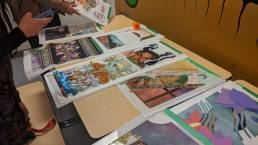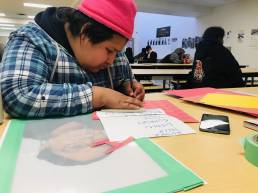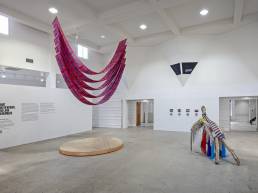Meet the Creatives: Recovering Community Space
May 4, 2022
By Chris Hampton
Ontario Culture Days’ 2022 Creatives in Residence program is underway, and a fresh set of creative talents are busy making new work for the upcoming fall festival. Now, for the next five months, we get front-row seats as the residents develop their projects in communities across the province.
For this third edition, the creatives are thematically exploring access to resources, such as community space, food, local history and technology. Last year, the residents considered “ideas of resilience and resourcefulness, particularly in times of precarity and uncertainty,” says Meaghan Froh Metcalf, Ontario Culture Days Senior Adviser. She sees the 2022 themes as an evolution of the conversations begun by the previous class. “Artists are still thinking about their relationships to themselves, to their communities, to their peers, and they’re still thinking about the connections that we’ve lost as a result of the past two years.”
Today, we’ll introduce you to the 2022 Creatives in Residence who are responding to our first theme: Community Space. Community spaces are sites, whether physical or figurative, that are vital to our collaboration, our communication of ideas and our cohesion as a society. Each of the three projects here strive to reimagine, reclaim and return to those spaces.
“The idea of community space has been these places to gather and learn from one another,” says Meaghan. “I think a lot of artists have been reflecting on their peers, but also the artists who have come before them and after them, as well as the different opportunities we have for intergenerational learning — this sense of learning amongst each other and really being able to be inspired by one another.”
Jamii
Shortly after Isorine Marc immigrated to Canada, she moved into co-op housing in Toronto’s Esplanade neighbourhood. As a member of the co-op, she had to volunteer a few hours each month. When a neighbour asked how she’d like to dedicate her time, Marc said she would organize an arts festival; after all, that’s what she had experience doing. She began arranging little events — storytelling sessions, movie nights — in the courtyard of the building complex.
“It was very eye-opening,” Isorine says. “From one day to the next, neighbours, instead of living next to each other, started to live more with each other, because we had shared an experience.”
The events eventually outgrew the courtyard, and in 2011 Marc founded Jamii (Swahili for “community”) as a non-profit organization that uses cultural activities to foster community engagement within the Esplanade.
There are three main branches within Jamii’s programming: they act as presenters, bringing art into the Esplanade for exhibition; they bring artists into the community to collaborate with residents and create artwork together; they partner with other communities around the globe to build connections and create meaningful cultural exchanges.
Jamii began one such partnership with the Pikangikum First Nation in 2018. The remote community is roughly 1,400 km away from the Esplanade, near the Ontario-Manitoba border. Most recently, a group of young Esplanadian women curated the work of four Pikangikum photographers in an outdoor exhibition hosted in the Toronto neighbourhood. “We were able to create a bridge by having their photographs transform a space within our community,” Isorine says.
This year, as part of the residency, Jamii will continue to grow the relationship, visiting Pikangikum with a group of artists from the Esplanade to make work with members of the Pikangikum community. The end products of the collaboration are yet unknown. Rather, it’s this process of co-creation that’s most important: they will determine the shape the project takes together.
Tanya Lukin Linklater
Tanya Lukin Linklater is an acclaimed Alutiiq/Sugpiaq multidisciplinary artist based in North Bay, Ont. Her work has been shown at the New Museum Triennial, the San Francisco Museum of Modern Art, and the Art Gallery of Ontario, to name a few venues from her extensive exhibition history.
Be it installation, performance, works for the camera or text, Lukin Linklater’s art always flows from a body of research. “I really lead,” she says, “from a place of asking questions and working with ideas.” Some of the subjects she’s investigated recently include ancestral or cultural belongings, collection storage spaces like museums, “histories and how histories are unfolding in the present moment,” Indigenous knowledge, as well as notions of repair and recovery within Indigenous communities.
Three Lukin Linklater artworks are currently included in the Toronto Biennial of Art. Spanning media and discipline, this suite of works exemplifies the incredible breadth of her artistic practice. Held in the air I never fell (spring lightning sweetgrass song) consists of an elliptical performance platform made of ash and copper, above which five 20-foot-long kohkum scarves hang in an arch. Kohkum (Cree for “grandmother”) scarves are floral-patterned lengths of fabric worn by Indigenous women and increasingly by water protectors and land defenders as a sign of Indigenous solidarity.
Another work, The sky held me (rainfall on hands hair lips) is a series of open rehearsals that will take place in Toronto’s High Park over five days in May between Lukin Linklater, three dancers and a composer/musician. The third piece, titled Sensation is a circuit of experience, a circuit of the felt traveling in and adjacent to the body, is a four-channel video installation in which the artist worked remotely with four dancers who each physically interpreted textual prompts (or “scores”) Lukin Linklater had composed, together choreographing a series of short performances.
For her Ontario Culture Days residency, she will be publishing these creative “scores,” giving the public an opportunity to interpret and activate the compositions themselves. “Publication is a way to leave a footprint that exists beyond the exhibition,” Lukin Linklater says. This collaboration, which began with just a small group, can grow into a larger and larger collective as her text travels.
A Body of Water by Aria Evans. Copyright Aria Evans. Video courtesy of Project Nishin.
Sarah Gartshore and Adam Francis Proulx
Sarah Gartshore and Adam Francis Proulx are both theatre artists. Gartshore is based in Sudbury and known predominantly as a playwright. Proulx, on the other hand, spends his time between Sault Ste. Marie and Toronto, and is known for his work in puppetry. The pair, both Fringe North board members, co-led the very first edition of Project Nishin in 2020.
Initially conceived as a COVID pivot, the project — which commissioned and facilitated a group of Indigenous creatives to produce original works of video — immediately established itself as a vital space for community, connection and storytelling.
“In all of my work, my intention is to serve the people,” Gartshore says. “My creative work is an extension of the heartwork I do in my community.”
Proulx says that growing up in a town better known for hockey and steel, he discovered his community in the theatre. The Creatives in Residence theme, Community Space, will grant him the opportunity to “really dig into” what he says he already know to be true: “art is all based on community.”
For the residency, Gartshore and Proulx will lead a new edition of Project Nishin, featuring a new roster of makers. “To me, the most exciting part about the project is that there are no parameters for them,” Proulx says. “They are welcome to work independently, as a team, to create videos, sound, dance, theatre, whatever … The goal is to see what these incredible artists do when we take away the box; to see what they do outside of the parameters usually thrust upon them by public funding, organizations, festivals, etc. Hopefully, they will end up having a meaningful experience in the process, and with a portfolio piece that is authentically ‘them.’”
The Creatives in Residence community programs will be open to the public during our festival in September and October 2022.



